Analysis of Business Operations in Healthcare Settings
VerifiedAdded on 2023/06/03
|12
|2203
|143
AI Summary
This assignment identifies the problem zones in healthcare settings and recommends solutions to improve service levels. Techniques such as TQM, Six Sigma, and Lean Production can help reduce wastes and improve efficiency. The supply chain needs to be made robust to reduce unnecessary movements.
Contribute Materials
Your contribution can guide someone’s learning journey. Share your
documents today.

Running head: ANALYSIS OF BUSINESS OPERATIONS
Analysis of Business Operations
Name of the student:
Name of the university:
Author note:
Analysis of Business Operations
Name of the student:
Name of the university:
Author note:
Secure Best Marks with AI Grader
Need help grading? Try our AI Grader for instant feedback on your assignments.
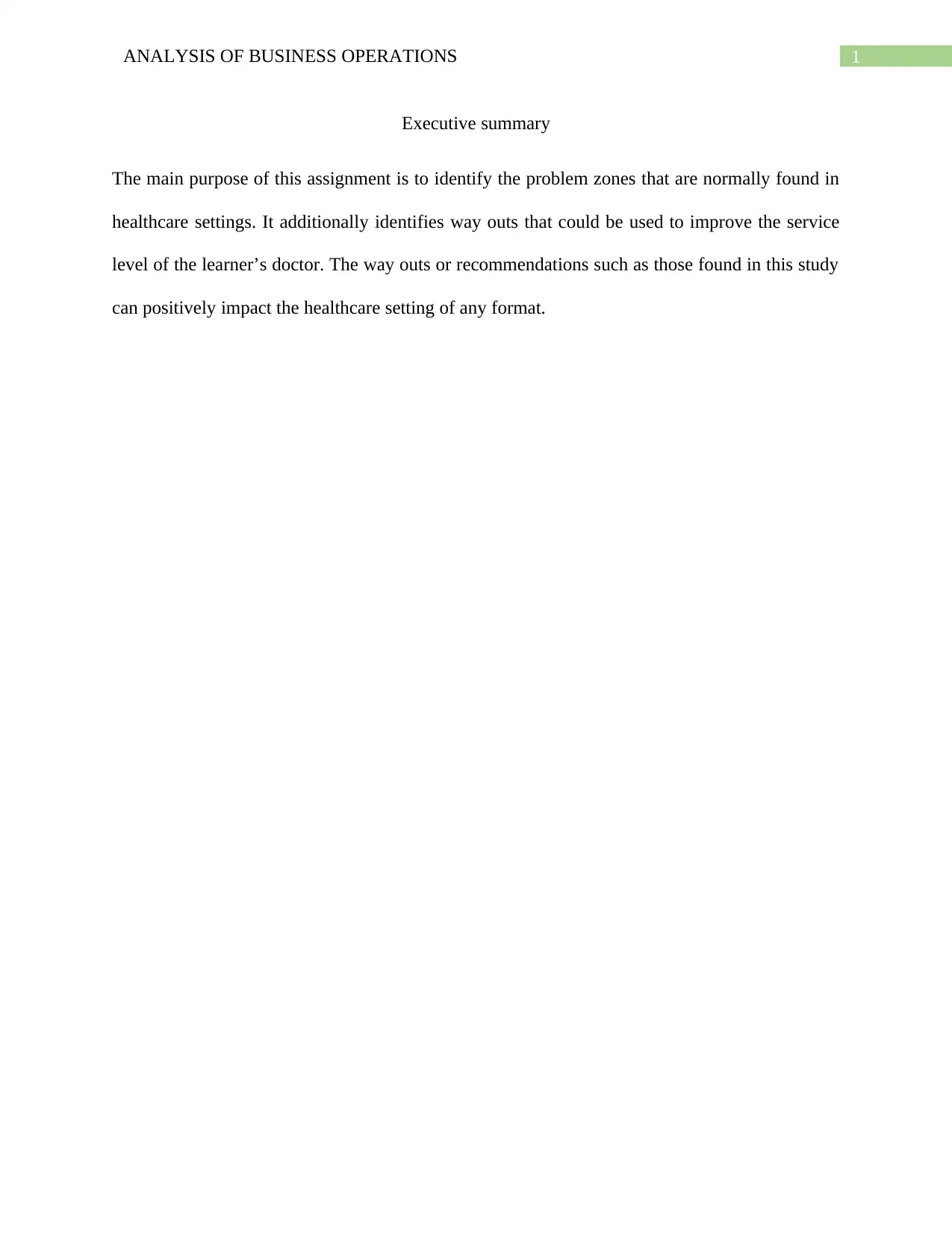
1ANALYSIS OF BUSINESS OPERATIONS
Executive summary
The main purpose of this assignment is to identify the problem zones that are normally found in
healthcare settings. It additionally identifies way outs that could be used to improve the service
level of the learner’s doctor. The way outs or recommendations such as those found in this study
can positively impact the healthcare setting of any format.
Executive summary
The main purpose of this assignment is to identify the problem zones that are normally found in
healthcare settings. It additionally identifies way outs that could be used to improve the service
level of the learner’s doctor. The way outs or recommendations such as those found in this study
can positively impact the healthcare setting of any format.
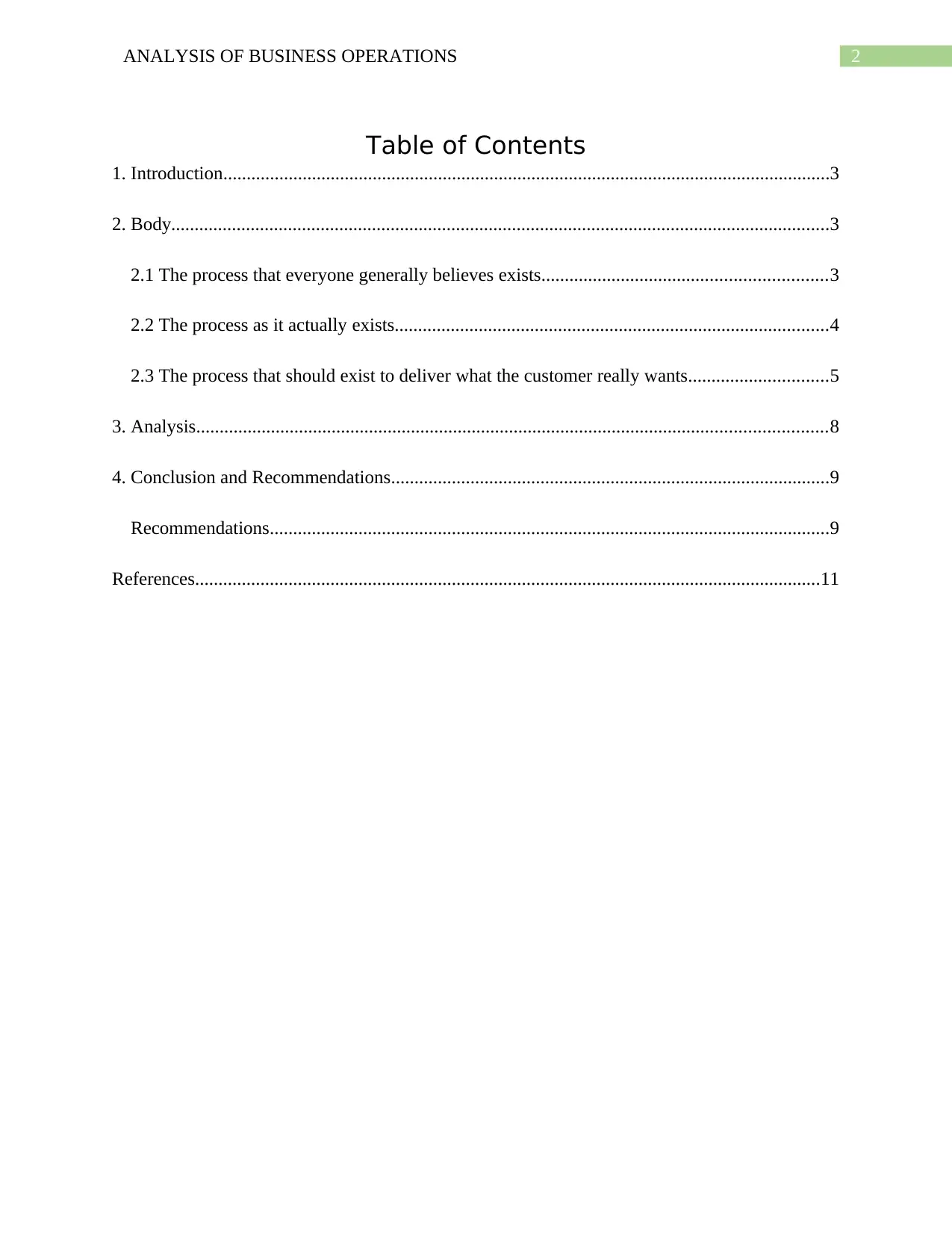
2ANALYSIS OF BUSINESS OPERATIONS
Table of Contents
1. Introduction..................................................................................................................................3
2. Body.............................................................................................................................................3
2.1 The process that everyone generally believes exists.............................................................3
2.2 The process as it actually exists.............................................................................................4
2.3 The process that should exist to deliver what the customer really wants..............................5
3. Analysis.......................................................................................................................................8
4. Conclusion and Recommendations..............................................................................................9
Recommendations........................................................................................................................9
References......................................................................................................................................11
Table of Contents
1. Introduction..................................................................................................................................3
2. Body.............................................................................................................................................3
2.1 The process that everyone generally believes exists.............................................................3
2.2 The process as it actually exists.............................................................................................4
2.3 The process that should exist to deliver what the customer really wants..............................5
3. Analysis.......................................................................................................................................8
4. Conclusion and Recommendations..............................................................................................9
Recommendations........................................................................................................................9
References......................................................................................................................................11
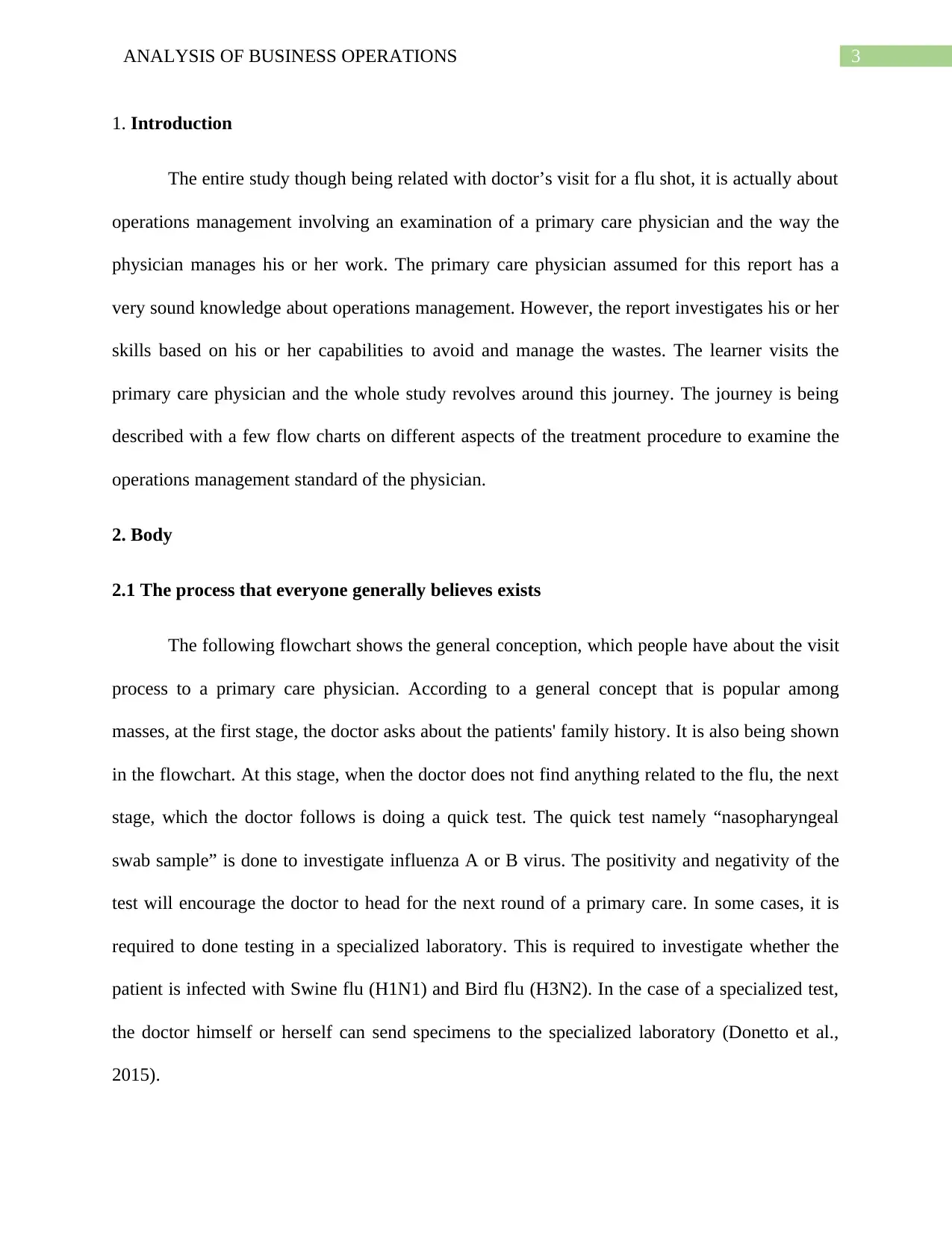
3ANALYSIS OF BUSINESS OPERATIONS
1. Introduction
The entire study though being related with doctor’s visit for a flu shot, it is actually about
operations management involving an examination of a primary care physician and the way the
physician manages his or her work. The primary care physician assumed for this report has a
very sound knowledge about operations management. However, the report investigates his or her
skills based on his or her capabilities to avoid and manage the wastes. The learner visits the
primary care physician and the whole study revolves around this journey. The journey is being
described with a few flow charts on different aspects of the treatment procedure to examine the
operations management standard of the physician.
2. Body
2.1 The process that everyone generally believes exists
The following flowchart shows the general conception, which people have about the visit
process to a primary care physician. According to a general concept that is popular among
masses, at the first stage, the doctor asks about the patients' family history. It is also being shown
in the flowchart. At this stage, when the doctor does not find anything related to the flu, the next
stage, which the doctor follows is doing a quick test. The quick test namely “nasopharyngeal
swab sample” is done to investigate influenza A or B virus. The positivity and negativity of the
test will encourage the doctor to head for the next round of a primary care. In some cases, it is
required to done testing in a specialized laboratory. This is required to investigate whether the
patient is infected with Swine flu (H1N1) and Bird flu (H3N2). In the case of a specialized test,
the doctor himself or herself can send specimens to the specialized laboratory (Donetto et al.,
2015).
1. Introduction
The entire study though being related with doctor’s visit for a flu shot, it is actually about
operations management involving an examination of a primary care physician and the way the
physician manages his or her work. The primary care physician assumed for this report has a
very sound knowledge about operations management. However, the report investigates his or her
skills based on his or her capabilities to avoid and manage the wastes. The learner visits the
primary care physician and the whole study revolves around this journey. The journey is being
described with a few flow charts on different aspects of the treatment procedure to examine the
operations management standard of the physician.
2. Body
2.1 The process that everyone generally believes exists
The following flowchart shows the general conception, which people have about the visit
process to a primary care physician. According to a general concept that is popular among
masses, at the first stage, the doctor asks about the patients' family history. It is also being shown
in the flowchart. At this stage, when the doctor does not find anything related to the flu, the next
stage, which the doctor follows is doing a quick test. The quick test namely “nasopharyngeal
swab sample” is done to investigate influenza A or B virus. The positivity and negativity of the
test will encourage the doctor to head for the next round of a primary care. In some cases, it is
required to done testing in a specialized laboratory. This is required to investigate whether the
patient is infected with Swine flu (H1N1) and Bird flu (H3N2). In the case of a specialized test,
the doctor himself or herself can send specimens to the specialized laboratory (Donetto et al.,
2015).
Secure Best Marks with AI Grader
Need help grading? Try our AI Grader for instant feedback on your assignments.
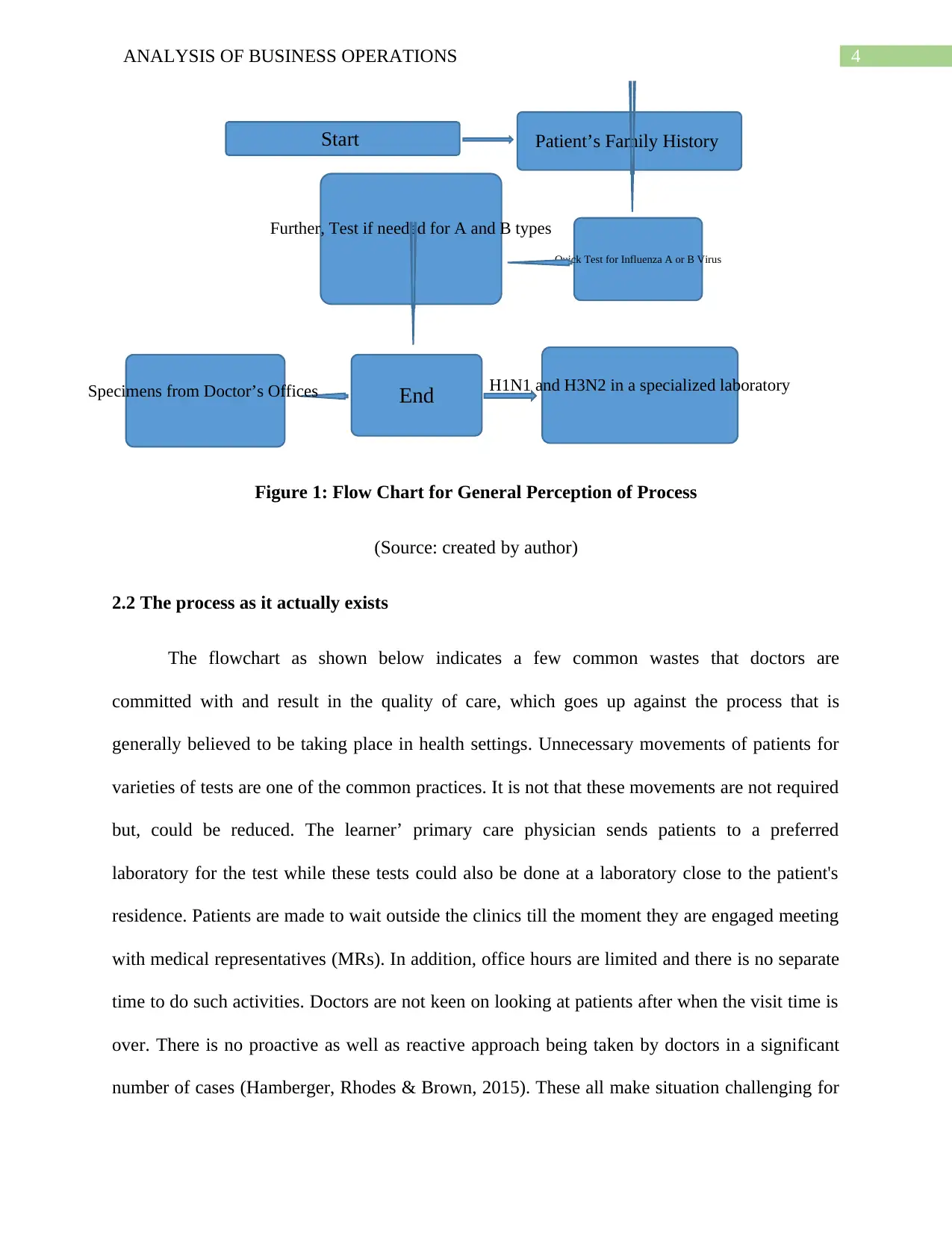
4ANALYSIS OF BUSINESS OPERATIONS
Start Patient’s Family History
Quick Test for Influenza A or B Virus
Further, Test if needed for A and B types
End H1N1 and H3N2 in a specialized laboratorySpecimens from Doctor’s Offices
Figure 1: Flow Chart for General Perception of Process
(Source: created by author)
2.2 The process as it actually exists
The flowchart as shown below indicates a few common wastes that doctors are
committed with and result in the quality of care, which goes up against the process that is
generally believed to be taking place in health settings. Unnecessary movements of patients for
varieties of tests are one of the common practices. It is not that these movements are not required
but, could be reduced. The learner’ primary care physician sends patients to a preferred
laboratory for the test while these tests could also be done at a laboratory close to the patient's
residence. Patients are made to wait outside the clinics till the moment they are engaged meeting
with medical representatives (MRs). In addition, office hours are limited and there is no separate
time to do such activities. Doctors are not keen on looking at patients after when the visit time is
over. There is no proactive as well as reactive approach being taken by doctors in a significant
number of cases (Hamberger, Rhodes & Brown, 2015). These all make situation challenging for
Start Patient’s Family History
Quick Test for Influenza A or B Virus
Further, Test if needed for A and B types
End H1N1 and H3N2 in a specialized laboratorySpecimens from Doctor’s Offices
Figure 1: Flow Chart for General Perception of Process
(Source: created by author)
2.2 The process as it actually exists
The flowchart as shown below indicates a few common wastes that doctors are
committed with and result in the quality of care, which goes up against the process that is
generally believed to be taking place in health settings. Unnecessary movements of patients for
varieties of tests are one of the common practices. It is not that these movements are not required
but, could be reduced. The learner’ primary care physician sends patients to a preferred
laboratory for the test while these tests could also be done at a laboratory close to the patient's
residence. Patients are made to wait outside the clinics till the moment they are engaged meeting
with medical representatives (MRs). In addition, office hours are limited and there is no separate
time to do such activities. Doctors are not keen on looking at patients after when the visit time is
over. There is no proactive as well as reactive approach being taken by doctors in a significant
number of cases (Hamberger, Rhodes & Brown, 2015). These all make situation challenging for
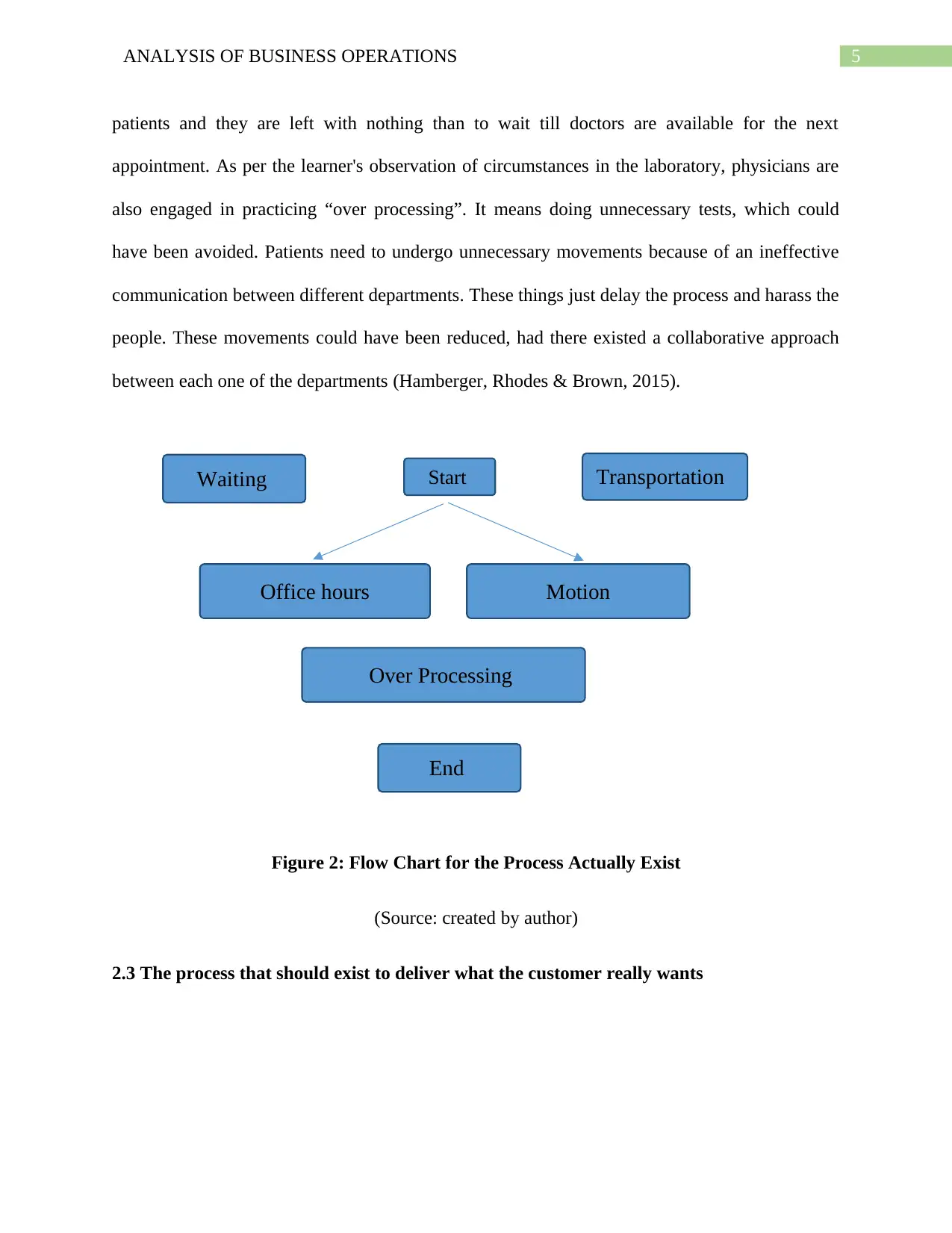
5ANALYSIS OF BUSINESS OPERATIONS
Start Transportation
Office hours Motion
Waiting
Over Processing
End
patients and they are left with nothing than to wait till doctors are available for the next
appointment. As per the learner's observation of circumstances in the laboratory, physicians are
also engaged in practicing “over processing”. It means doing unnecessary tests, which could
have been avoided. Patients need to undergo unnecessary movements because of an ineffective
communication between different departments. These things just delay the process and harass the
people. These movements could have been reduced, had there existed a collaborative approach
between each one of the departments (Hamberger, Rhodes & Brown, 2015).
Figure 2: Flow Chart for the Process Actually Exist
(Source: created by author)
2.3 The process that should exist to deliver what the customer really wants
Start Transportation
Office hours Motion
Waiting
Over Processing
End
patients and they are left with nothing than to wait till doctors are available for the next
appointment. As per the learner's observation of circumstances in the laboratory, physicians are
also engaged in practicing “over processing”. It means doing unnecessary tests, which could
have been avoided. Patients need to undergo unnecessary movements because of an ineffective
communication between different departments. These things just delay the process and harass the
people. These movements could have been reduced, had there existed a collaborative approach
between each one of the departments (Hamberger, Rhodes & Brown, 2015).
Figure 2: Flow Chart for the Process Actually Exist
(Source: created by author)
2.3 The process that should exist to deliver what the customer really wants
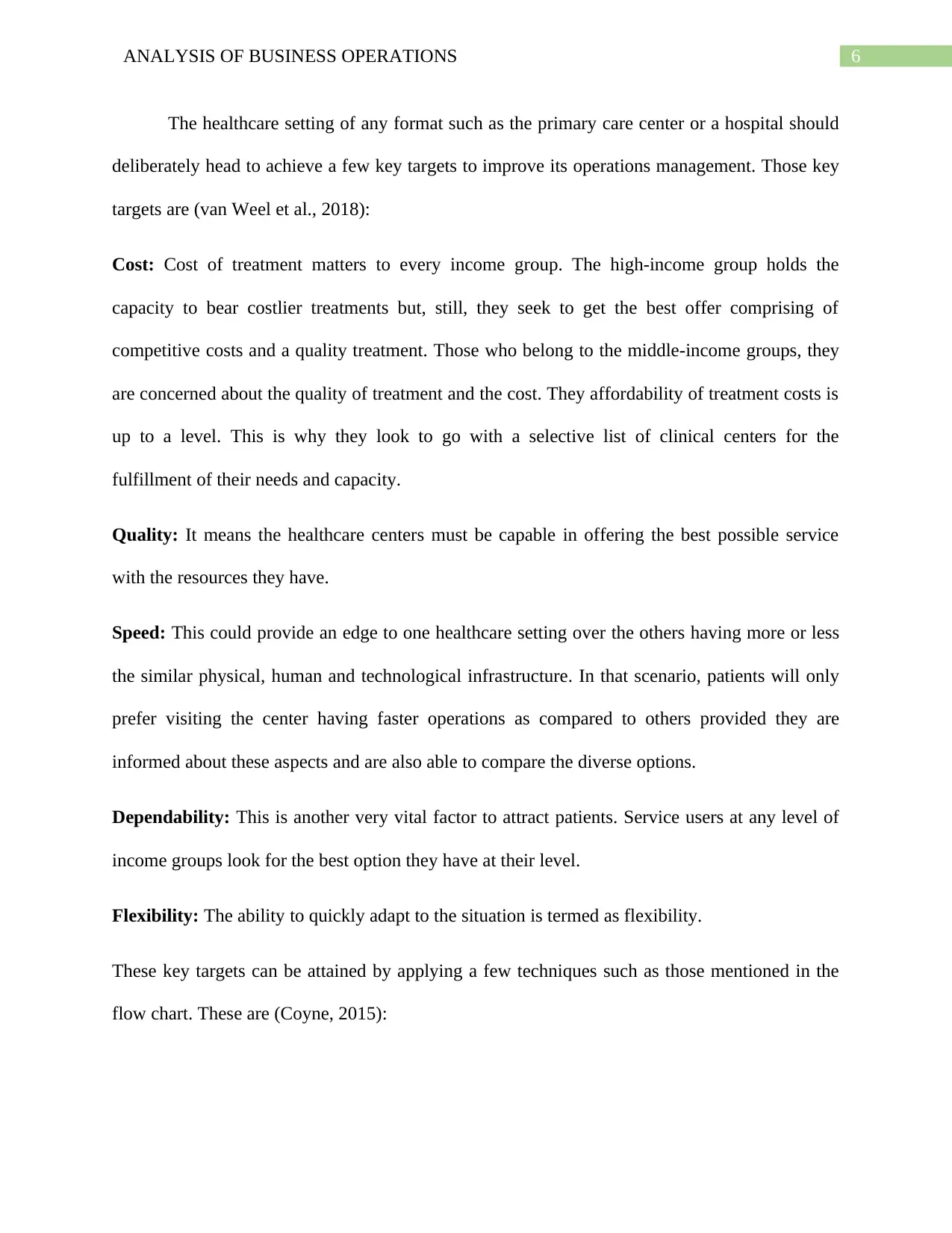
6ANALYSIS OF BUSINESS OPERATIONS
The healthcare setting of any format such as the primary care center or a hospital should
deliberately head to achieve a few key targets to improve its operations management. Those key
targets are (van Weel et al., 2018):
Cost: Cost of treatment matters to every income group. The high-income group holds the
capacity to bear costlier treatments but, still, they seek to get the best offer comprising of
competitive costs and a quality treatment. Those who belong to the middle-income groups, they
are concerned about the quality of treatment and the cost. They affordability of treatment costs is
up to a level. This is why they look to go with a selective list of clinical centers for the
fulfillment of their needs and capacity.
Quality: It means the healthcare centers must be capable in offering the best possible service
with the resources they have.
Speed: This could provide an edge to one healthcare setting over the others having more or less
the similar physical, human and technological infrastructure. In that scenario, patients will only
prefer visiting the center having faster operations as compared to others provided they are
informed about these aspects and are also able to compare the diverse options.
Dependability: This is another very vital factor to attract patients. Service users at any level of
income groups look for the best option they have at their level.
Flexibility: The ability to quickly adapt to the situation is termed as flexibility.
These key targets can be attained by applying a few techniques such as those mentioned in the
flow chart. These are (Coyne, 2015):
The healthcare setting of any format such as the primary care center or a hospital should
deliberately head to achieve a few key targets to improve its operations management. Those key
targets are (van Weel et al., 2018):
Cost: Cost of treatment matters to every income group. The high-income group holds the
capacity to bear costlier treatments but, still, they seek to get the best offer comprising of
competitive costs and a quality treatment. Those who belong to the middle-income groups, they
are concerned about the quality of treatment and the cost. They affordability of treatment costs is
up to a level. This is why they look to go with a selective list of clinical centers for the
fulfillment of their needs and capacity.
Quality: It means the healthcare centers must be capable in offering the best possible service
with the resources they have.
Speed: This could provide an edge to one healthcare setting over the others having more or less
the similar physical, human and technological infrastructure. In that scenario, patients will only
prefer visiting the center having faster operations as compared to others provided they are
informed about these aspects and are also able to compare the diverse options.
Dependability: This is another very vital factor to attract patients. Service users at any level of
income groups look for the best option they have at their level.
Flexibility: The ability to quickly adapt to the situation is termed as flexibility.
These key targets can be attained by applying a few techniques such as those mentioned in the
flow chart. These are (Coyne, 2015):
Paraphrase This Document
Need a fresh take? Get an instant paraphrase of this document with our AI Paraphraser
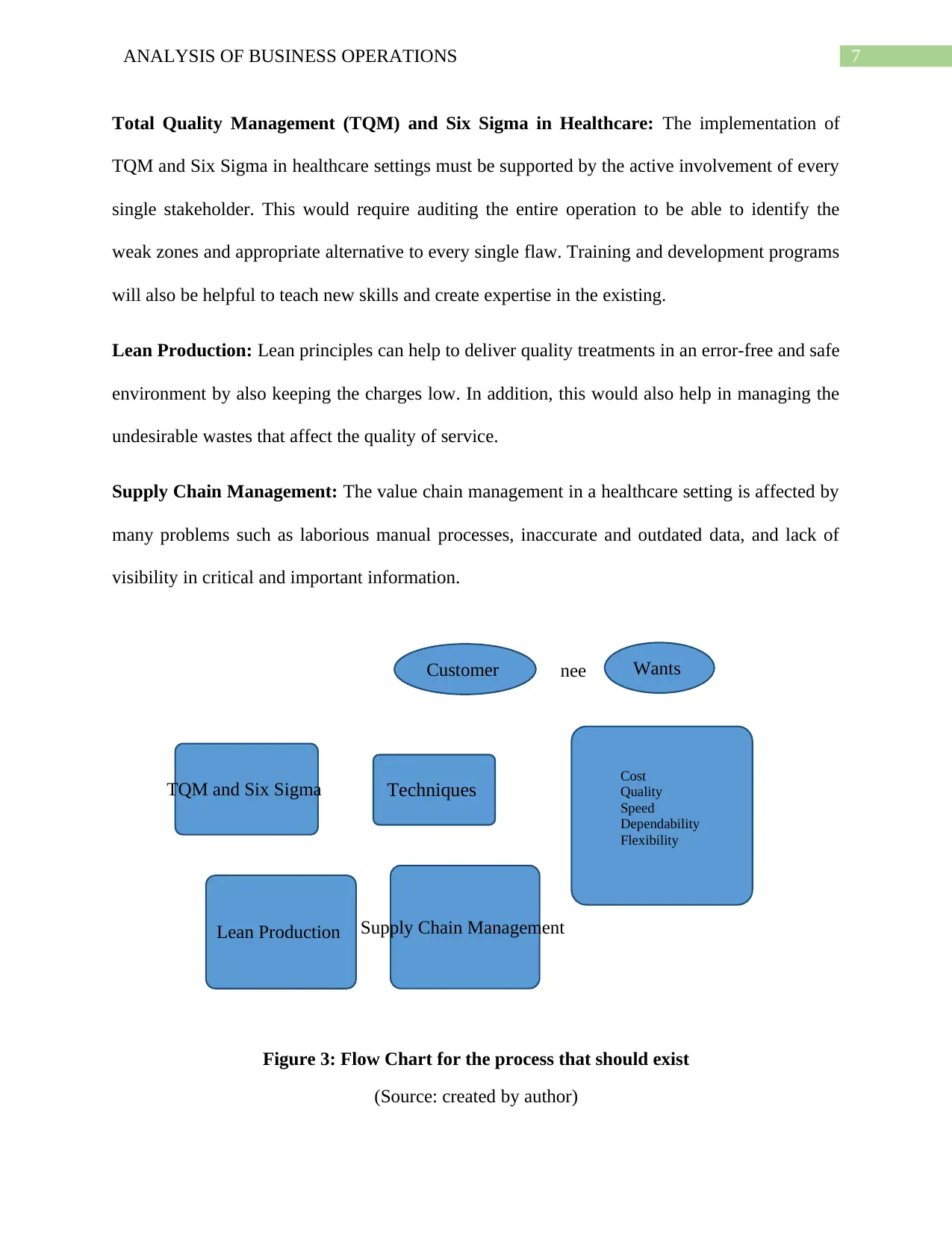
7ANALYSIS OF BUSINESS OPERATIONS
Customer nee Wants
Cost
Quality
Speed
Dependability
Flexibility
TechniquesTQM and Six Sigma
Supply Chain ManagementLean Production
Total Quality Management (TQM) and Six Sigma in Healthcare: The implementation of
TQM and Six Sigma in healthcare settings must be supported by the active involvement of every
single stakeholder. This would require auditing the entire operation to be able to identify the
weak zones and appropriate alternative to every single flaw. Training and development programs
will also be helpful to teach new skills and create expertise in the existing.
Lean Production: Lean principles can help to deliver quality treatments in an error-free and safe
environment by also keeping the charges low. In addition, this would also help in managing the
undesirable wastes that affect the quality of service.
Supply Chain Management: The value chain management in a healthcare setting is affected by
many problems such as laborious manual processes, inaccurate and outdated data, and lack of
visibility in critical and important information.
Figure 3: Flow Chart for the process that should exist
(Source: created by author)
Customer nee Wants
Cost
Quality
Speed
Dependability
Flexibility
TechniquesTQM and Six Sigma
Supply Chain ManagementLean Production
Total Quality Management (TQM) and Six Sigma in Healthcare: The implementation of
TQM and Six Sigma in healthcare settings must be supported by the active involvement of every
single stakeholder. This would require auditing the entire operation to be able to identify the
weak zones and appropriate alternative to every single flaw. Training and development programs
will also be helpful to teach new skills and create expertise in the existing.
Lean Production: Lean principles can help to deliver quality treatments in an error-free and safe
environment by also keeping the charges low. In addition, this would also help in managing the
undesirable wastes that affect the quality of service.
Supply Chain Management: The value chain management in a healthcare setting is affected by
many problems such as laborious manual processes, inaccurate and outdated data, and lack of
visibility in critical and important information.
Figure 3: Flow Chart for the process that should exist
(Source: created by author)
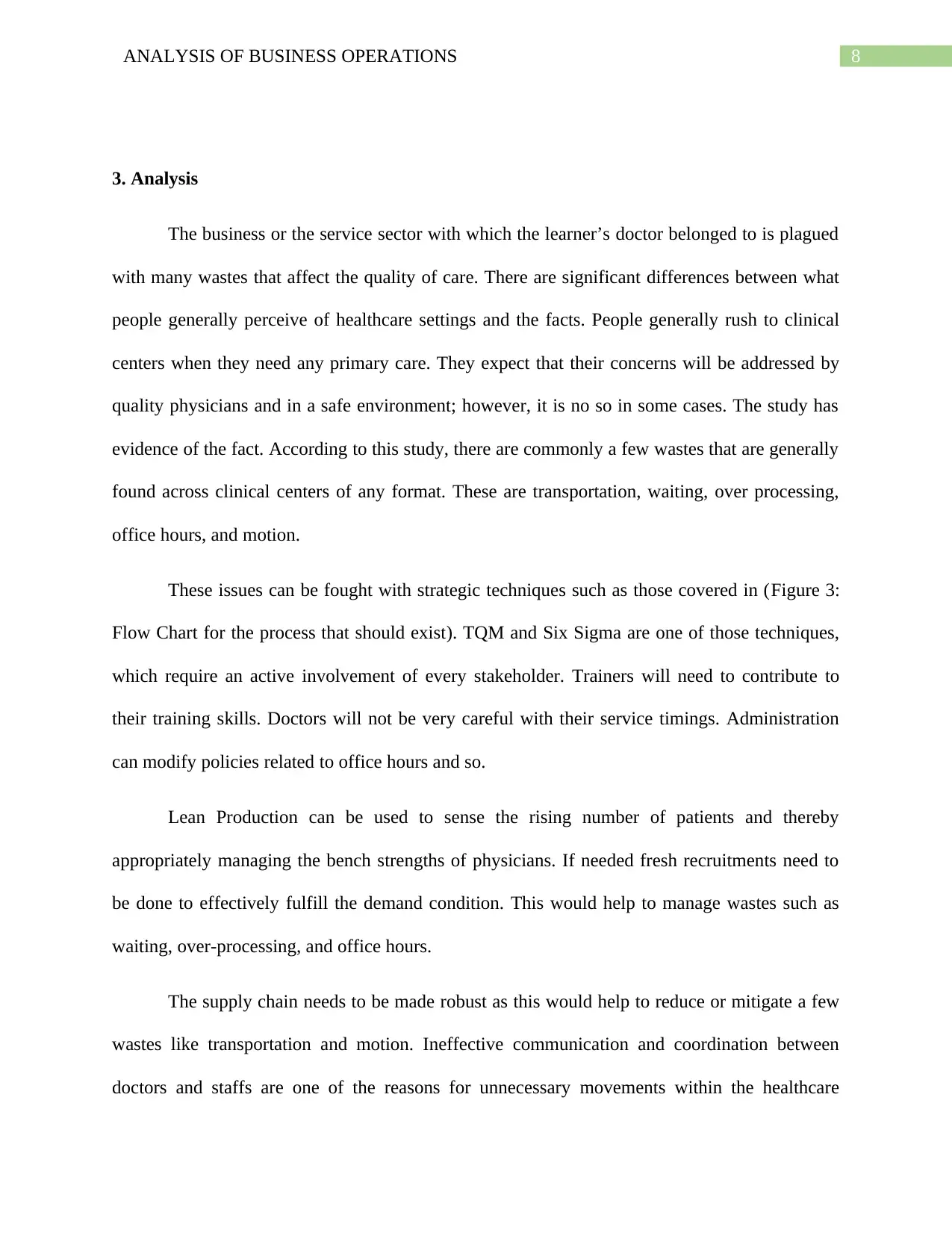
8ANALYSIS OF BUSINESS OPERATIONS
3. Analysis
The business or the service sector with which the learner’s doctor belonged to is plagued
with many wastes that affect the quality of care. There are significant differences between what
people generally perceive of healthcare settings and the facts. People generally rush to clinical
centers when they need any primary care. They expect that their concerns will be addressed by
quality physicians and in a safe environment; however, it is no so in some cases. The study has
evidence of the fact. According to this study, there are commonly a few wastes that are generally
found across clinical centers of any format. These are transportation, waiting, over processing,
office hours, and motion.
These issues can be fought with strategic techniques such as those covered in (Figure 3:
Flow Chart for the process that should exist). TQM and Six Sigma are one of those techniques,
which require an active involvement of every stakeholder. Trainers will need to contribute to
their training skills. Doctors will not be very careful with their service timings. Administration
can modify policies related to office hours and so.
Lean Production can be used to sense the rising number of patients and thereby
appropriately managing the bench strengths of physicians. If needed fresh recruitments need to
be done to effectively fulfill the demand condition. This would help to manage wastes such as
waiting, over-processing, and office hours.
The supply chain needs to be made robust as this would help to reduce or mitigate a few
wastes like transportation and motion. Ineffective communication and coordination between
doctors and staffs are one of the reasons for unnecessary movements within the healthcare
3. Analysis
The business or the service sector with which the learner’s doctor belonged to is plagued
with many wastes that affect the quality of care. There are significant differences between what
people generally perceive of healthcare settings and the facts. People generally rush to clinical
centers when they need any primary care. They expect that their concerns will be addressed by
quality physicians and in a safe environment; however, it is no so in some cases. The study has
evidence of the fact. According to this study, there are commonly a few wastes that are generally
found across clinical centers of any format. These are transportation, waiting, over processing,
office hours, and motion.
These issues can be fought with strategic techniques such as those covered in (Figure 3:
Flow Chart for the process that should exist). TQM and Six Sigma are one of those techniques,
which require an active involvement of every stakeholder. Trainers will need to contribute to
their training skills. Doctors will not be very careful with their service timings. Administration
can modify policies related to office hours and so.
Lean Production can be used to sense the rising number of patients and thereby
appropriately managing the bench strengths of physicians. If needed fresh recruitments need to
be done to effectively fulfill the demand condition. This would help to manage wastes such as
waiting, over-processing, and office hours.
The supply chain needs to be made robust as this would help to reduce or mitigate a few
wastes like transportation and motion. Ineffective communication and coordination between
doctors and staffs are one of the reasons for unnecessary movements within the healthcare
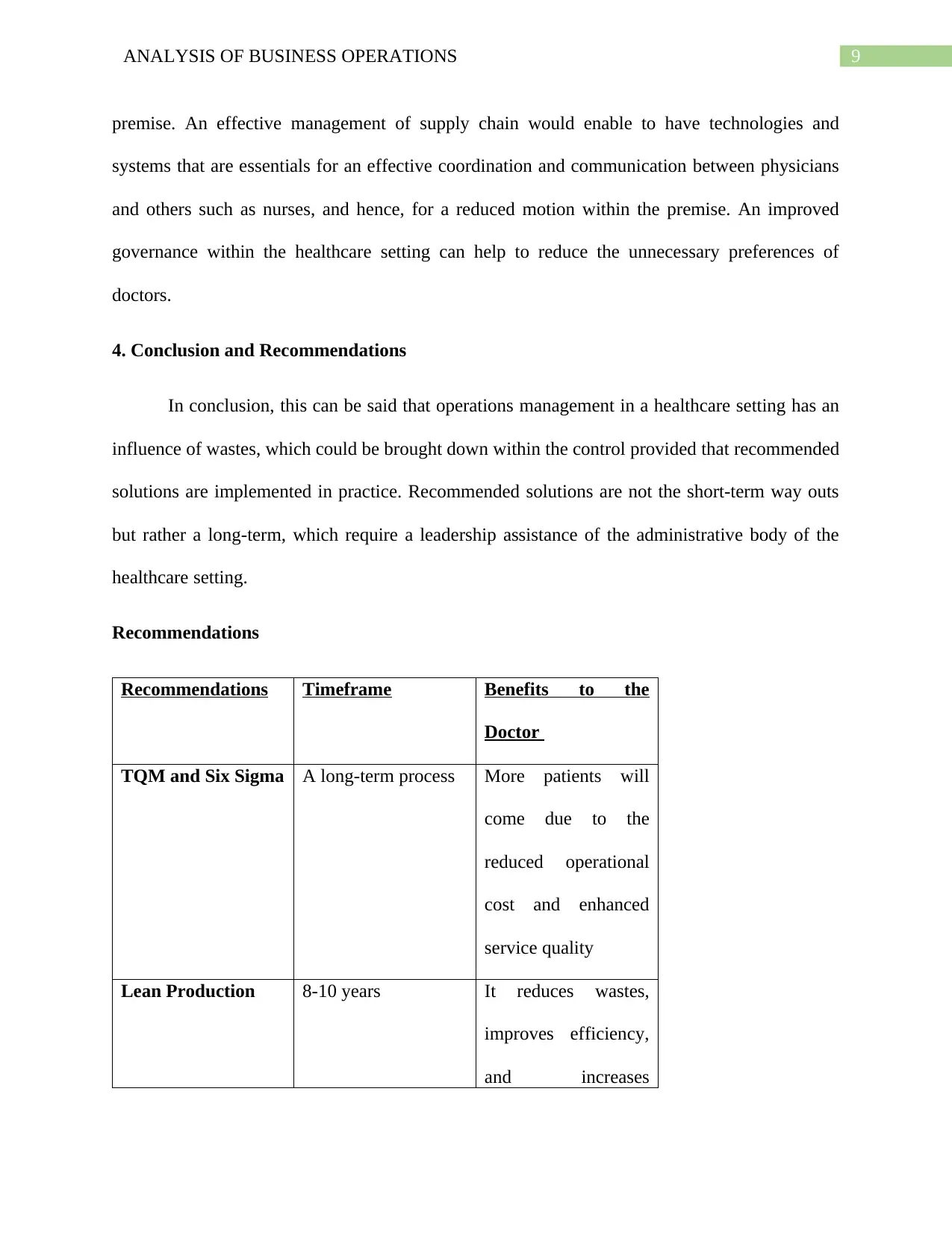
9ANALYSIS OF BUSINESS OPERATIONS
premise. An effective management of supply chain would enable to have technologies and
systems that are essentials for an effective coordination and communication between physicians
and others such as nurses, and hence, for a reduced motion within the premise. An improved
governance within the healthcare setting can help to reduce the unnecessary preferences of
doctors.
4. Conclusion and Recommendations
In conclusion, this can be said that operations management in a healthcare setting has an
influence of wastes, which could be brought down within the control provided that recommended
solutions are implemented in practice. Recommended solutions are not the short-term way outs
but rather a long-term, which require a leadership assistance of the administrative body of the
healthcare setting.
Recommendations
Recommendations Timeframe Benefits to the
Doctor
TQM and Six Sigma A long-term process More patients will
come due to the
reduced operational
cost and enhanced
service quality
Lean Production 8-10 years It reduces wastes,
improves efficiency,
and increases
premise. An effective management of supply chain would enable to have technologies and
systems that are essentials for an effective coordination and communication between physicians
and others such as nurses, and hence, for a reduced motion within the premise. An improved
governance within the healthcare setting can help to reduce the unnecessary preferences of
doctors.
4. Conclusion and Recommendations
In conclusion, this can be said that operations management in a healthcare setting has an
influence of wastes, which could be brought down within the control provided that recommended
solutions are implemented in practice. Recommended solutions are not the short-term way outs
but rather a long-term, which require a leadership assistance of the administrative body of the
healthcare setting.
Recommendations
Recommendations Timeframe Benefits to the
Doctor
TQM and Six Sigma A long-term process More patients will
come due to the
reduced operational
cost and enhanced
service quality
Lean Production 8-10 years It reduces wastes,
improves efficiency,
and increases
Secure Best Marks with AI Grader
Need help grading? Try our AI Grader for instant feedback on your assignments.
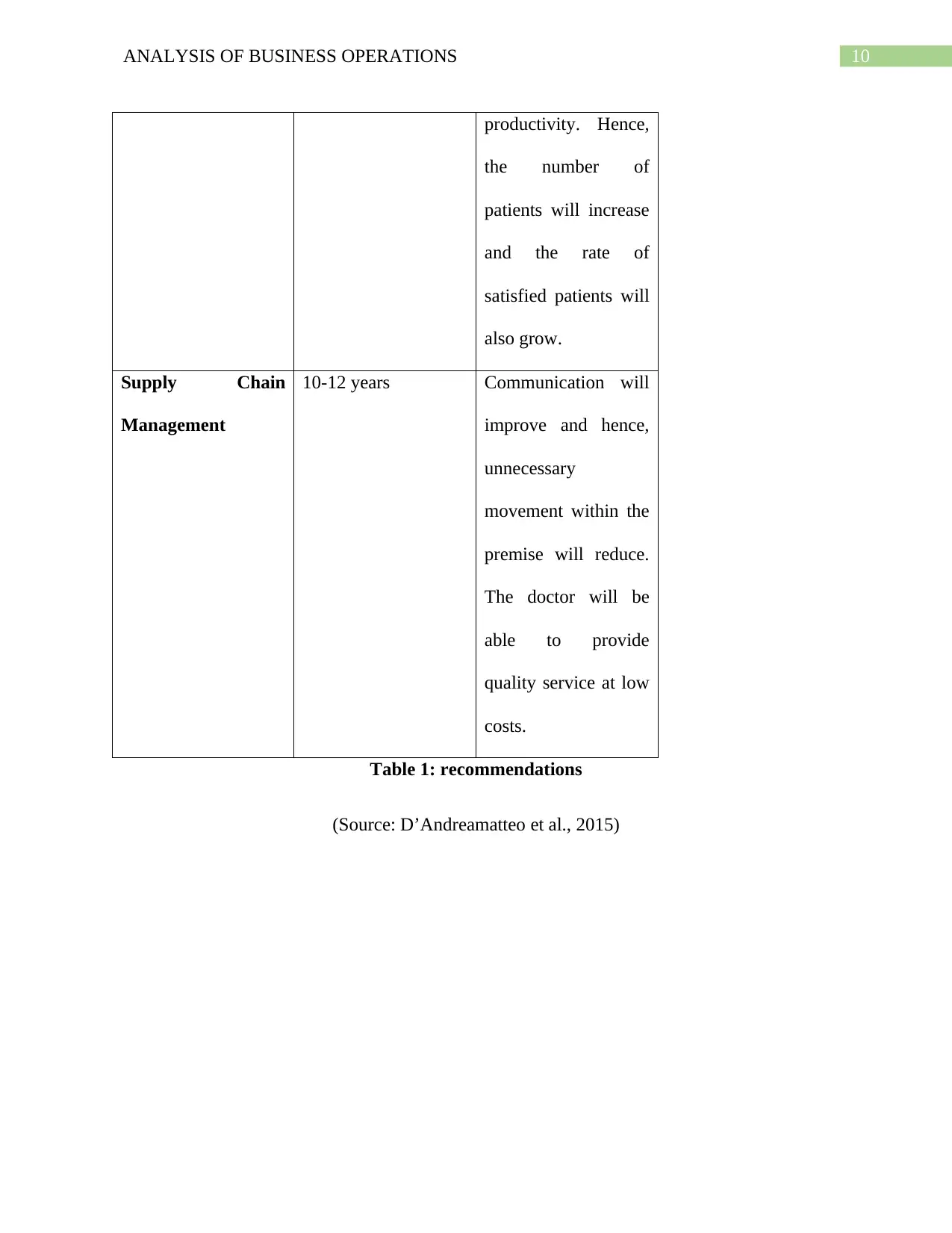
10ANALYSIS OF BUSINESS OPERATIONS
productivity. Hence,
the number of
patients will increase
and the rate of
satisfied patients will
also grow.
Supply Chain
Management
10-12 years Communication will
improve and hence,
unnecessary
movement within the
premise will reduce.
The doctor will be
able to provide
quality service at low
costs.
Table 1: recommendations
(Source: D’Andreamatteo et al., 2015)
productivity. Hence,
the number of
patients will increase
and the rate of
satisfied patients will
also grow.
Supply Chain
Management
10-12 years Communication will
improve and hence,
unnecessary
movement within the
premise will reduce.
The doctor will be
able to provide
quality service at low
costs.
Table 1: recommendations
(Source: D’Andreamatteo et al., 2015)
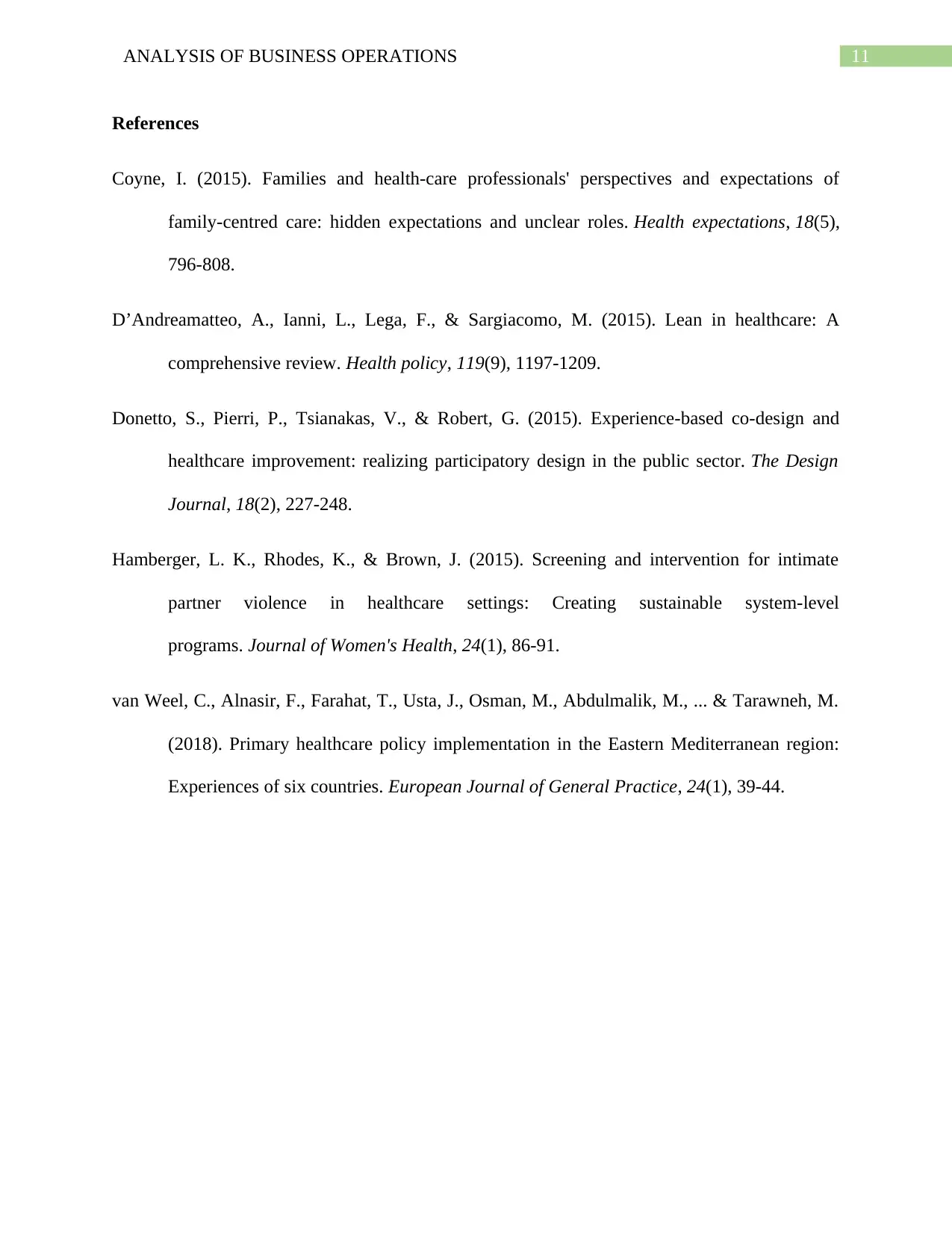
11ANALYSIS OF BUSINESS OPERATIONS
References
Coyne, I. (2015). Families and health‐care professionals' perspectives and expectations of
family‐centred care: hidden expectations and unclear roles. Health expectations, 18(5),
796-808.
D’Andreamatteo, A., Ianni, L., Lega, F., & Sargiacomo, M. (2015). Lean in healthcare: A
comprehensive review. Health policy, 119(9), 1197-1209.
Donetto, S., Pierri, P., Tsianakas, V., & Robert, G. (2015). Experience-based co-design and
healthcare improvement: realizing participatory design in the public sector. The Design
Journal, 18(2), 227-248.
Hamberger, L. K., Rhodes, K., & Brown, J. (2015). Screening and intervention for intimate
partner violence in healthcare settings: Creating sustainable system-level
programs. Journal of Women's Health, 24(1), 86-91.
van Weel, C., Alnasir, F., Farahat, T., Usta, J., Osman, M., Abdulmalik, M., ... & Tarawneh, M.
(2018). Primary healthcare policy implementation in the Eastern Mediterranean region:
Experiences of six countries. European Journal of General Practice, 24(1), 39-44.
References
Coyne, I. (2015). Families and health‐care professionals' perspectives and expectations of
family‐centred care: hidden expectations and unclear roles. Health expectations, 18(5),
796-808.
D’Andreamatteo, A., Ianni, L., Lega, F., & Sargiacomo, M. (2015). Lean in healthcare: A
comprehensive review. Health policy, 119(9), 1197-1209.
Donetto, S., Pierri, P., Tsianakas, V., & Robert, G. (2015). Experience-based co-design and
healthcare improvement: realizing participatory design in the public sector. The Design
Journal, 18(2), 227-248.
Hamberger, L. K., Rhodes, K., & Brown, J. (2015). Screening and intervention for intimate
partner violence in healthcare settings: Creating sustainable system-level
programs. Journal of Women's Health, 24(1), 86-91.
van Weel, C., Alnasir, F., Farahat, T., Usta, J., Osman, M., Abdulmalik, M., ... & Tarawneh, M.
(2018). Primary healthcare policy implementation in the Eastern Mediterranean region:
Experiences of six countries. European Journal of General Practice, 24(1), 39-44.
1 out of 12
Your All-in-One AI-Powered Toolkit for Academic Success.
+13062052269
info@desklib.com
Available 24*7 on WhatsApp / Email
![[object Object]](/_next/static/media/star-bottom.7253800d.svg)
Unlock your academic potential
© 2024 | Zucol Services PVT LTD | All rights reserved.
